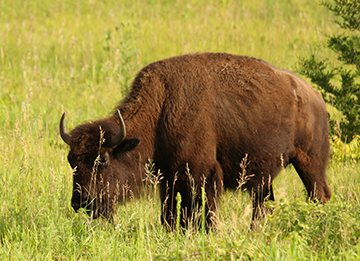 As part of the Spring Lake Park Master Plan, Dakota County reintroduced the American plains bison to the prairie.
As part of the Spring Lake Park Master Plan, Dakota County reintroduced the American plains bison to the prairie.
For many years, the prairies of Minnesota were maintained by three natural processes — climate, fire and grazing. This project added the last crucial element of grazing.
For information on how to see the bison, go to the Bison Prairie page.
Bison boost the prairie ecosystem
The main grazer of the prairie was the American plains bison. Bison feed mostly on grasses and focus their grazing in patches. Their grazing habits boost plant diversity by giving wildflowers the chance to compete with the tall grasses.
By boosting plant diversity, grazing helps to make the prairie resilient and stable, a key goal for natural resources within the county's parks.
Many other prairie species benefit from the presence of bison. The habitat for birds, butterflies, amphibians, bees and other mammals is enhanced. Bison contribute to seed dispersal and further plant diversity with their wallowing behaviors. Bison are an important element of the continued restoration and maintenance of prairie at Spring Lake Park Reserve.
Dakota County worked with the Minnesota Bison Conservation Herd Partnership to bring bison to Spring Lake Park Reserve in October 2022. The partnership seeks to establish a herd of 500 bison around the state that have no detectable cattle genes.
Construction complete
The facilities to keep the bison and park visitors safe are complete. We have constructed:
- Fencing
- Gates
- Watering stations
- A short, paved trail segment with an observation station
- Humane animal handling facility
 Map of bison range fence locations
Map of bison range fence locationsArrival of the bison
Dakota County received a small herd of bison from the partnership in early October 2022. During the first fall and winter, the bison remained in a remote part of the range within Spring Lake Park Reserve to give them time to get used to each other and their new home. This is to reduce their stress to keep them healthy and safe. A public welcoming took place in spring 2023.
The 2020-2022 budget for construction was $940,000. The bison reintroduction project was made possible with support from Dakota County and a $560,000 grant from the Minnesota Environment and Natural Resources Trust Fund as recommended by the Legislative-Citizen Commission on Minnesota Resources.
 Bison Fact Sheet
Bison Fact Sheet